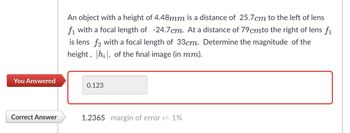
Physics for Scientists and Engineers: Foundations and Connections
1st Edition
ISBN: 9781133939146
Author: Katz, Debora M.
Publisher: Cengage Learning
expand_more
expand_more
format_list_bulleted
Question
An object with a height of 4.48mm is a distance of 25.7 cm to the left of lens f1 with a focal length of -24.7 cm. At a distance of 79cmto the right of lens f1 is lens fz with a focal length of 33cm. Determine the magnitude of the height, hi, of the final image (in mm). Check correct answer and show all work

Transcribed Image Text:An object with a height of 4.48mm is a distance of 25.7 cm to the left of lens
f1 with a focal length of -24.7cm. At a distance of 79 cmto the right of lens fi
is lens f2 with a focal length of 33cm. Determine the magnitude of the
height, hi, of the final image (in mm).
You Answered
0.123
Correct Answer
1.2365 margin of error +/- 1%
Expert Solution
This question has been solved!
Explore an expertly crafted, step-by-step solution for a thorough understanding of key concepts.
Step by stepSolved in 2 steps with 2 images

Knowledge Booster
Similar questions
- (a) Calculate the focal length of the mirror formed by the shiny back of a spoon that has a 3.00 cm radius of curvature. (b) What is its power in diopters?arrow_forwardShow that the magnification of a thin lens is given by M = di/do (Eq. 38.6). Hint: Follow the derivation of the lens makers equation (page 1233) and start with a thick lens.arrow_forwardA water fountain is at the center of a circular pool as shown in Figure P1.59. A student walks around the pool and measures its circumference C. Next, he stands at the edge of the pool and uses a protractor to measure the angle of elevation of his sightline to the top of the water jet. How high is the fountain?arrow_forward
- A converging lens made of crown glass has a focal length of 15.0 cm when used in air. If the lens is immersed in water, what is its focal length? (a) negative (b) less than 15.0 cm (c) equal to 15.0 cm (d) greater than 15.0 cm (e) none of those answersarrow_forwardA camera lens used for taking close-up photographs has a focal length of 22.0 mm. The farthest it can be placed from the film is 33.0 mm. (a) What is the closest object that can be photographed? (b) What is the magnification of this closest object?arrow_forward(a) Where does an object need to be placed relative to a microscope for its 0.500 cm focal leng1h objective to produce a magnification of 400? (b) Where should the 5.00 cm focal length eyepiece be placed to produce a further fourfold (4.00) magnification?arrow_forward
- . If the mirror described in the previous problem is used to form an image of the same object now located 16 cm in front of the mirror, what would the new image position be? Assuming that the magnification equations developed for lenses also apply to mirrors, describe the image (size and orientation) thus formed.arrow_forwardA converging lens has a focal length of 10.0 cm. Locate the object if a real image is located at a distance from the lens of (a) 20.0 cm and (b) 50.0 cm. What If? Redo the calculations if the images are virtual and located at a distance from the lens of (c) 20.0 cm and (d) 50.0 cm.arrow_forwardA diverging lens has a focal length of 20 cm. What is the power of the lens in diopters?arrow_forward
- How far should you hold a 2.1 cm-focal length magnifying glass from an object to obtain a magnification of 10 x ? Assume you place your eye 5.0 cm from the magnifying glass.arrow_forward. (a) In a camera equipped with a 50-mm focal-length lens, the maximum distance that the lens can be from the film is 60 mm. What is the smallest distance an object can be from the camera if its image on the film is to be in focus? What is the magnification? (b) An extension tube is added between the lens and the camera body so that the lens can be positioned 100 mm from film. How close can the object be now? What is the magnification?arrow_forwardA particular patients eyes are unable to focus on objects closer than 35.0 cm and corrective lenses are to be prescribed so that the patient can focus on objects 20.0 cm from their eyes. (a) Is the patient nearsighted or farsighted? (b) If contact lenses are to lie prescribed, determine the required lens power. (c) If eyeglasses are to be prescribed instead and the distance between the eyes and the lenses is 2.00 cm, determine the power of the required corrective lenses. (d) Are the required lenses converging or diverging?arrow_forward
arrow_back_ios
SEE MORE QUESTIONS
arrow_forward_ios
Recommended textbooks for you
 Physics for Scientists and Engineers: Foundations...PhysicsISBN:9781133939146Author:Katz, Debora M.Publisher:Cengage Learning
Physics for Scientists and Engineers: Foundations...PhysicsISBN:9781133939146Author:Katz, Debora M.Publisher:Cengage Learning College PhysicsPhysicsISBN:9781938168000Author:Paul Peter Urone, Roger HinrichsPublisher:OpenStax College
College PhysicsPhysicsISBN:9781938168000Author:Paul Peter Urone, Roger HinrichsPublisher:OpenStax College College PhysicsPhysicsISBN:9781285737027Author:Raymond A. Serway, Chris VuillePublisher:Cengage Learning
College PhysicsPhysicsISBN:9781285737027Author:Raymond A. Serway, Chris VuillePublisher:Cengage Learning Physics for Scientists and Engineers, Technology ...PhysicsISBN:9781305116399Author:Raymond A. Serway, John W. JewettPublisher:Cengage Learning
Physics for Scientists and Engineers, Technology ...PhysicsISBN:9781305116399Author:Raymond A. Serway, John W. JewettPublisher:Cengage Learning Principles of Physics: A Calculus-Based TextPhysicsISBN:9781133104261Author:Raymond A. Serway, John W. JewettPublisher:Cengage Learning
Principles of Physics: A Calculus-Based TextPhysicsISBN:9781133104261Author:Raymond A. Serway, John W. JewettPublisher:Cengage Learning

Physics for Scientists and Engineers: Foundations...
Physics
ISBN:9781133939146
Author:Katz, Debora M.
Publisher:Cengage Learning

College Physics
Physics
ISBN:9781938168000
Author:Paul Peter Urone, Roger Hinrichs
Publisher:OpenStax College

College Physics
Physics
ISBN:9781285737027
Author:Raymond A. Serway, Chris Vuille
Publisher:Cengage Learning

Physics for Scientists and Engineers, Technology ...
Physics
ISBN:9781305116399
Author:Raymond A. Serway, John W. Jewett
Publisher:Cengage Learning

Principles of Physics: A Calculus-Based Text
Physics
ISBN:9781133104261
Author:Raymond A. Serway, John W. Jewett
Publisher:Cengage Learning
